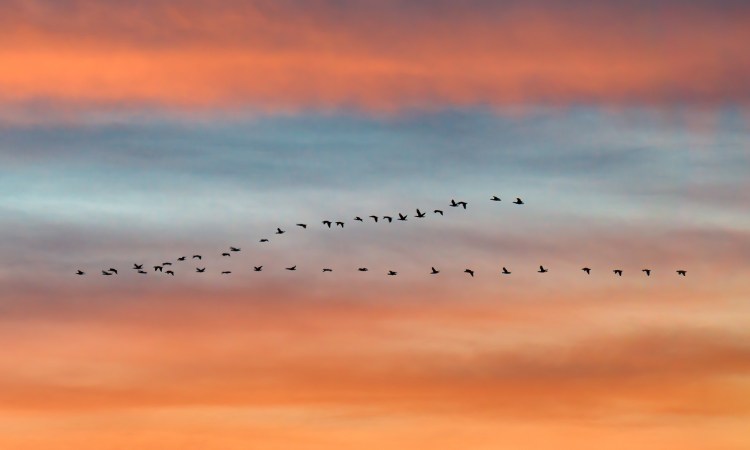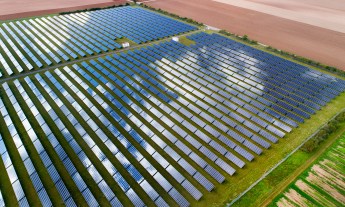
From geese flying through the sky in formation to schools of fish swimming in the ocean, the world’s creatures show an efficiency that is the envy of physicists, architects and designers. Writer Gary Ferguson explains the inspiration that we humans can draw from how energy flows in the natural world.
More energy falls from the sun in just an hour and a half than all the energy humans consume from all sources in an entire year. Given that all life on the planet comes directly or indirectly from this sunlight, it might seem odd to learn that nature puts an enormous emphasis on efficiency.
Why would there be efficiency in the face of such abundance? Yet every leaf on every tree is tuned down to the subatomic level for gathering as much light as possible into every pore. Every creature, meanwhile, is flush with an ease of movement and spooling of body functions, showing an efficiency that’s long been the envy of physicists, architects and design engineers. Indeed, much of today’s cutting-edge technology is an attempt to mimic biological efficiency, whether we’re talking about bullet trains or vaccines or water filters or wind farms.
Each living being has been fated to make the best use of the essential nourishment sunlight offers, without wasting a drop.
As it happens, nature loves efficiency because living beings can only capture so much of the energy available to them. Also, whenever a life-form takes in fuel — whether directly from the sun, like a blade of grass, or indirectly, like when the impala eats the grass, or the lion eats the impala, a lot of energy is required to turn it into something usable. So yes, we live on a planet with an endless supply of energy. But from a biological perspective, each living being has been fated to work out a puzzle where the name of the game is to make the best use of the essential nourishment sunlight offers, without wasting a drop.
In the most basic sense the purpose of life is to keep more life flowing and unfolding in as many trees, as many butterflies, as many wild roses as the ecosystem will allow. That takes efficiency, and those species that prove best at it live the longest, and live best.
Jack Gladstone, a Grammy-nominated Blackfeet musician living at the edge of Glacier National Park, has an interesting way of framing all this. He says that what he focuses on in music is really what drives all of life, every species, every ecosystem. “It comes down to three things,” he says. “Harmony, balance, and rhythm.” Whoever and whatever masters those will have a successful life.
All of nature does in fact turn on those three things, and each one can be understood in terms of energy. Harmony, for example, can be seen as not pushing against whatever’s happening in any given moment but rather adjusting to move with the flow. A migrating duck caught in a fierce headwind, instead of exhausting itself, may land and wait for more favorable conditions. Balance, can be understood as striving for an equilibrium between energy coming in and that going out. That same duck will stop and fill up on grain well before her body has to start breaking down muscle cells in order to feed itself for the exertion of flight. And rhythm includes the daily, seasonal and lifetime cycles that steer us all — creating alternating beats of strong activity and calm restoration. A bear, facing cold, snowy weather and therefore the end of easily available food, will crawl into a den, lower her metabolism to a tiny fraction of what it was, and sleep until the first signs of spring.
No matter where we look, we find nature using harmony, balance, and rhythm — the artistic infrastructure of conservation. Right now on earth we think there are about 60,000 mammals, birds, reptiles and fish and more than 300,000 different kinds of plants. All of them have survived by building lives of exquisite efficiency.
Living things are continually investing energy to create more of it, yet again, there’s no end of efficiency when it comes to carrying out that task.
Birds fly, lions run, bees make honey, flowers unfold, apples ripen, fish swim, trees reach for the sky — all with expenditures of energy trimmed to the subatomic level. Your body does this, too. Each of your cells has come up with a neat way of burning sugar from the food you eat, doing so in tiny steps. With every step a little energy is released, some of which gets stored in special carrier molecules, available for later use. Technically, if all that sugar got burned at once, it would produce the same amount of energy. But energy coming in a big burst like that would be more than your cells could actually make use of. Which means a lot of it would go to waste; lost — as all energy finally is — in the form of heat. It’s sort of like a person trying to keep herself warm through an entire night with a campfire. She’ll fare better if she feeds the logs as they’re needed, rather than dumping the whole woodpile into the flames at once.
Living things are continually investing energy to create more of it. Life, when you think about it, is really about creating more life. Yet again, there’s no end of efficiency when it comes to carrying out that task. Maybe there’s something we can apply from that in how we think, the decisions we make, how we go through our lives.
The next time you have the chance, turn your gaze to the sky to see if you can catch the ancient spectacle of wild geese winging southward — flying through skies just ahead of the cold slap of winter. You’ll probably hear them first, then see them, cruising at 40, 50, even 60 miles per hour, tiny specks drifting over a patchwork of brown grass and stubbled fields and the freshly bared arms of maples and ash and oaks.
Were you somehow able to ascend into the skies and be among them, you’d notice one thing right away. The lead bird is in a delicate dance of body adjustment, always minimizing the energy she’s putting out by leaning into and out of the most subtle wind currents. And if your day of flying happened to be in the uplands maybe the White Mountains of New Hampshire, or the Adirondacks, or the Rockies or Sierras, you’d also see a kind of exquisite roller coastering in the flock as it maneuvers across the terrain. Whenever possible, the birds drop into the lower valleys — taking advantage of greater air density at those lower elevations, which allows them to catch more air with every wing stroke. That means they use less energy. Then when the time comes, they rise together to cross the high divides.
Drafting allows geese to fly about 70 percent farther than they could on their own. Each goose will take the lead slot for about the same amount of time, and then spend the rest of its journey drafting behind other birds.
Then there’s a behavior you’ve probably noticed before — called “drafting,” it plays out in a familiar V formation in birds around the world. Drafting allows followers to benefit from aerodynamic washup, not only avoiding headwinds but actually gaining lift from the birds in front. On one hand, it’s about flying in just the right place. But it’s also about stroking your wings at just the right time. If you were up there right next to the birds, you’d see that it’s a beautifully refined technique, perfectly tuned. So much so that researchers estimate drafting allows geese to fly about 70 percent farther than they could if they were traveling on their own. Each goose will take the lead slot for about the same amount of time, and then will spend the rest of its journey drafting behind other birds — rotating from the head to the back and then moving up again, bird by bird by bird.
This avian dance is accomplished in part through a steady stream of communication and that throaty honking you hear, which includes routine check-ins between the leaders and those in the back of the flock to keep track of how everyone’s doing. Should one of the geese start struggling or, say, become injured during hunting season — typically two other birds will fall out of formation with it, follow it to the ground, and remain there until their companion either recovers or dies.
We humans have taken some of what we’ve learned from these wild geese and applied it quite literally. That’s how we ended up with World War I military pilots mimicking flying-goose patterns in their formations, putting aerodynamic washup to use for much the same reasons as the birds do: to gain lift, to reduce headwinds, to minimize the energy required to travel, and to keep each plane in visual contact with the others in case of trouble.
We’ve learned similar lessons from schooling fish. And in particular, from the beautiful, enchanting flutter of large groups of fish moving en masse through the water, the trailing fish effortlessly keeping perfect time with the leaders. This underwater dance is more than beautiful art. A single fish propels itself by twisting its body to create small eddies or whirlpools. The trailing fish wrap their bodies around those disturbances of water, and by doing so get pulled along. Learning from this particular slice of nature, a group of students from the California Institute of Technology decided to assemble vertical wind turbines in tightly packed groups, like schools of fish. That bit of biomimicry, as biologist Janine Benyus (watch her TED Talk: Biomimicry in action) points out, then produced a phenomenal tenfold increase in wind power.
It’s a powerful thought to imagine what it might look like to live in a world where families, workplaces, cities, and nations were more fully aligned with the idea of living efficiently, taking only what we need. To participate deeply in something the great Chinese philosopher Lao-tzu observed about the natural world, which is that “the way of nature is to take from what has excess in order to make good what is deficient.”
Excerpted with permission from the new book The Eight Master Lessons of Nature: What Nature Teaches Us About Living Well in the World by Gary Ferguson. Published by Dutton, an imprint of Penguin Random House LLC. Copyright © 2019 by Gary Ferguson.
Watch his TEDxBozeman Talk (with Mary M. Clare) here:












